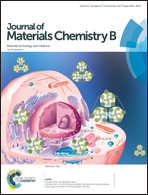Squid suckerin microneedle arrays for tunable drug release†
Abstract
Microneedles are increasingly used in transdermal delivery of therapeutic agents due to the elimination of first-pass metabolism, simplicity of operation, and lack of pain, which collectively lead to improved patient compliance. However, microneedles are still met by challenges with regard to the choice of biocompatible materials and the control of drug release profiles. Herein, we tackle these limitations by producing microneedles from a biocompatible robust biopolymer, namely squid sucker ring teeth (SRT) proteins (suckerins), using a soft lithography method. Taking advantage of the modular sequence design of suckerins leading to their self-assembly into β-sheet enriched structures, suckerin microneedles display an accurate replication of their templates with robust mechanical properties, endowing them with a high skin penetration capability. Critically, the β-sheet content in the microneedles can be modulated by varying the solvent conditions, which allows tuning of the mechanical response, and in turn the drug release rates by more than one order of magnitude. In vitro skin permeation studies of suckerin microneedles using human cadaver skin samples suggest a fast onset and enhanced skin permeation of drugs compared to flat patches. The skin permeation can also be tailored 10-fold by applying hydrogen bond disruptor solutions. As a proof-of-concept, the anti-bacterial drug kanamycin is encapsulated within the microneedles, leading to efficient anti-bacterial activity and offering an additional benefit to further minimize the risk of infections caused by microneedle-based drug delivery systems. Lastly, suckerin microneedles are found to be biocompatible in cell culture studies, opening the door to further clinical applications.



 Please wait while we load your content...
Please wait while we load your content...